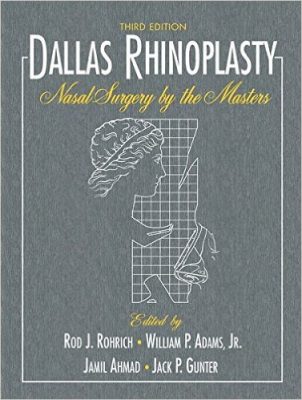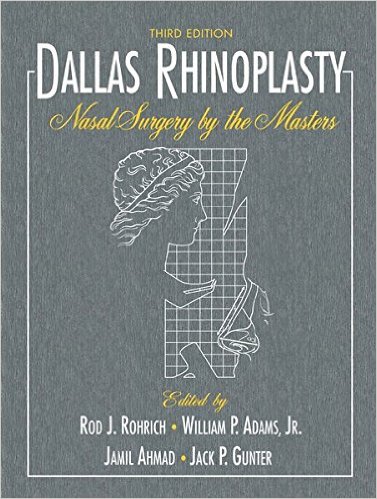 Editors: Rod J. Rohrich, MD: William P. Adams, Jr., MD; Jamil Ahmad, MD; and Jack P. Gunter, MD
Editors: Rod J. Rohrich, MD: William P. Adams, Jr., MD; Jamil Ahmad, MD; and Jack P. Gunter, MD
Publisher: Thieme – 1,604 pages
Book Review by: Nano Khilnani
The first edition of this book appeared in 2002, and it was the work mainly of those who attended the first annual Dallas Rhinoplasty Symposium in 1984. The second edition, published in 2007, had some updates to the content in some chapters, the latest advances in rhinoplasty, and video content showing anatomy dissections and surgical techniques which enhanced the multimedia experience for the user.
This third edition was published in 2014, and it contains much new content, including:
- Application of the open approach in rhinoplasty
- Further development of the techniques that increase precision, control, and consistency
- Updates of all chapters with concepts and techniques that have become widely accepted
- Additions of many new chapters providing practical approaches to key concepts, ideas and innovations that are now practiced and have enhanced the multimedia experience
- Expansion of video content and online access to these materials
The primary purpose of this book, write the editors, is “to assist the nasal surgeon in attaining consistent results using careful preoperative analysis, precise operative planning, meticulous intra-operative execution, and long-term follow-up with critical evaluation of results.”
For this book, 46 physicians and surgeons contributed content by authoring its 68 chapters. Almost all of them are from the United States, except two from Canada and one each from Brazil and Turkey. Most are specialists in aesthetic, plastic and reconstructive surgery, but some are in oral and maxillofacial surgery, otology, and otolaryngology – head and neck surgery.
Too many to list the titles of the 68 chapters, we provide below the names of the 11 Parts around which they are organized, so you can get an overview of the contents and know what is covered.
- Volume I
- Part 1 – Basic Perioperative Concepts
- Part 2 – Basic Surgical Concepts
- Part 3 – The Dorsum
- Part 4 – The Tip
- Part 5 – Alar Rims
- Part 6 – Alar Base
- Part 7 – The Chin
- Volume II
- Part 8 – Secondary Rhinoplasty
- Part 9 – Management of Airway Dysfunction
- Part 10 – Special Topics and Advances
- Part 11 – Personal Approaches and Philosophies
As a purchaser of this print edition you can access the E-book version and other valuable resources available for you online. Go to https://online.vitalsource.com/user/new, then:
- Create your VitalSource Bookshelf account or log on to it if you already have an account.
- Redeem the code by scratching off the grey film on the inside front cover of this book
You can download the E-book version of this book on your PC or Mac, iPhone, iPad Touch, iPad, Android phone or other smart phone, tablet, or on your Kindle Fire. If you have any questions whatever on downloading, please visit: http://support.vitalsource.com/
A very well organized book, Dallas Rhinoplasty reflects this quality when you browse through the materials in its many chapters, and take closer looks at some of them. We found chapter 10 (in Part 4) Getting Rhinoplasty Right the First Time, to be an inviting title, and likely a core part of this book, so we took a close look.
In the first paragraph of this chapter, the authors Rod J. Rohrich and Jamil Ahmad write that rhinoplasty “is a unique opportunity to manipulate undisturbed tissue,” but the surgical procedures must produce a result “that meets both aesthetic and functional goals.”
In the second paragraph, they present this list as among ‘the basic principles for successful primary rhinoplasty’ :
- Thorough clinical analysis and definition of goals preoperatively
- Careful preoperative preparation of the patient
- Precise operative execution
- Adequate postoperative management
- Expertise and experience gleaned from critical analysis of one’s own results
In the third paragraph they indicate that “this chapter will focus on lessons learned from a 25-year experience with primary rhinoplasty.”
Then the chapter authors lay out their Key Concepts and Strategies for Success:
- Use the open approach
- Incrementally reduce the dorsum
- Use invisible grafts
- The best chance to get the result is during the primary rhinoplasty
- Follow patients long term
This is followed by detailed discussions of each of the five key concepts and strategies stated above, along with how-to-steps and numerous sketches to illustrate how the procedures are to be done, and photos of patients as they are being worked on.
The chapter ends with a Conclusion which reiterates ‘basic principles’ and ‘key concepts and strategies’ for success. Finally, a list of References is provided at the end of the chapter.
This is an authoritative, comprehensive, detailed, and excellent textbook on the numerous and various aspects of rhinoplasty edited and written by highly knowledgeable and experienced physicians and surgeons in this specialty.
Editors:
Rod J. Rohrich, MD, FACS is Crystal Charity Ball Distinguished Chair in Plastic Surgery, Betty and Warren Woodward Chair in Plastic and Reconstructive Surgery, and Distinguished Teaching Professor in the Department of Plastic Surgery at the University of Texas Southwestern Medical Center in Dallas. Texas.
William P. Adams, Jr., MD is Associate Clinical Professor in the Department of Plastic Surgery at the University of Texas Southwestern Medical Center in Dallas. Texas.
Jamil Ahmad, MD, FRCSC is Director of Research and Education at the Plastic Surgery Clinic in Mississauga, Ontario, Canada; Lecturer and Director of the Education Program in Plastic Surgery in the Division of Plastic Surgery in the Department of Surgery at University of Toronto in Toronto, Ontario, Canada.
Editor Emeritus:
Jack P. Gunter, MD is Clinical Professor in the Departments of Plastic Surgery and Otolaryngology – Head and Neck Surgery, at the University of Texas Southwestern Medical Center in Dallas, Texas. He is also in private practice at the Gunter Center for Aesthetic and Cosmetic Surgery in Dallas, Texas.







